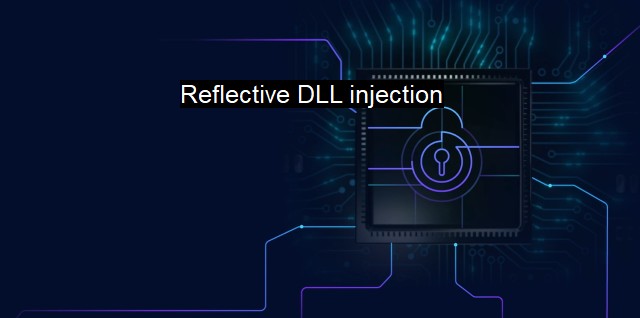What is Reflective DLL injection?
The Stealthy and Persistent Threat: Reflective DLL Injection
Reflective DLL Injection is a sophisticated hacking technique most commonly associated with cybersecurity and employed in the evasion of established antivirus software and systems. Fundamentally, it involves redirecting the actions of a process through the execution of an external Dynamic Link Library (DLL) to create stealthy and untraceable process alterations.Deeply founded the concept of Import Address Table (IAT), DLLs, and Portable Executable (PE) play critical roles in understanding this technique. Portable Executable is the standard file format for executable files, object codes, DLLs, and others used in 32-bit and 64-bit versions of Windows operating systems. DLLs, on the other hand, are modules of code and data which applications in Windows use to perform various tasks. Processes usually load DLLs into their address space by mapping them into memory. The IAT is also a crucial part of a PE file, containing pointers that connect to particular functions of statically-linked DLLs.
Reflective DLL Injection leverages these concepts to create a new method of executable injection into a foreign process. Unlike classic DLL injections, which entails the usage of systems API calls to go about this task, the tactics behind Reflective DLL Injection are much sneakier. This technique avoids the detection mechanisms installed in most antivirus programs by surreptitiously executing its very own loading sequence.
This begins with the instigation of a shellcode, a particular type of code employed in exploiting vulnerabilities. Once initiated, it lays the groundwork for the Reflective DLL injection by mapping the DLL into the address space of the target application. This mapping differs from traditional methods by replicating the actions that the Windows loader would perform without resorting to Kernel or User APIs, thereby avoiding any traceable artifacts that could alert security systems.
The executed DLLs never touch the disk, leaving no trace and no reason for antivirus programs to complain. Mass strings of properly injected code, including malicious payloads, can run without detection, strategically hiding in plain sight within the target host. It is specifically designed for runtime DLL injection and to evade standard DLL load event recording attempts.
Yet, like every form of clandestine digital misdeed, Reflective DLL Injection is far from undetectable. Careful monitoring using newer intrusion detection techniques of system calls cycles can fish out suspicions DLL loadings that might signify a manifesting malware attack. Code and heuristic analyses are also useful in predicting the existence of malware by tracing unusual API activities.
Defending against Reflective DLL Injection requires advanced security controls like API sandboxing, drilling traffic analysis, detailed endpoint threat detection, and responses in both user and kernel space. Multi-layered defense mechanisms, including behavior and memory-scanning antivirus programs, have shown-bearing results.
Reflective DLL Injection takes DLL hijacking a step further by injectively moving a DLL into a process while keeping it away from the mapped module list and the DLL load event is hazardously quiet. It creates a backdoor that flies under the radar of standard antivirus scanning systems. Enhancing our understanding of Reflective DLL Injection is vital for strengthening existing security systems. The concealed invasion and exploitation of process threads underline its advanced intrusion capabilities, yet detections and defenses concomitantly evolve. the many aid prevention and response systems strive to foil this technique's covert maneuvers, leaving no stones unturned with regards to fortifying our computer systems' security.

Reflective DLL injection FAQs
What is reflective DLL injection?
Reflective DLL injection is a technique used by cyber attackers to load and execute malicious code into a legitimate process's memory space without having to call traditional Windows APIs. This method allows attackers to bypass antivirus and other security measures that rely on detecting API calls.How does reflective DLL injection work?
Reflective DLL injection works by mapping the malicious DLL into the memory space of a legitimate process and executing it from there. This technique allows attackers to avoid detection by antivirus software, which typically looks for API calls made by malicious code.What are the risks associated with reflective DLL injection?
Reflective DLL injection can be used for a wide range of cyber attacks, including stealing data, spying on user activity, and taking control of a compromised system. It can also be used to bypass antivirus and other security measures, making it a popular technique among cybercriminals.How can I protect my system from reflective DLL injection attacks?
To protect your system from reflective DLL injection attacks, you should regularly update your antivirus software, apply security patches and updates to your operating system and other software, and monitor your system for suspicious activity. You can also use security tools that are specifically designed to detect and prevent reflective DLL injection attacks.| | A | | | B | | | C | | | D | | | E | | | F | | | G | | | H | | | I | | | J | | | K | | | L | | | M | |
| | N | | | O | | | P | | | Q | | | R | | | S | | | T | | | U | | | V | | | W | | | X | | | Y | | | Z | |
| | 1 | | | 2 | | | 3 | | | 4 | | | 7 | | | 8 | | |||||||